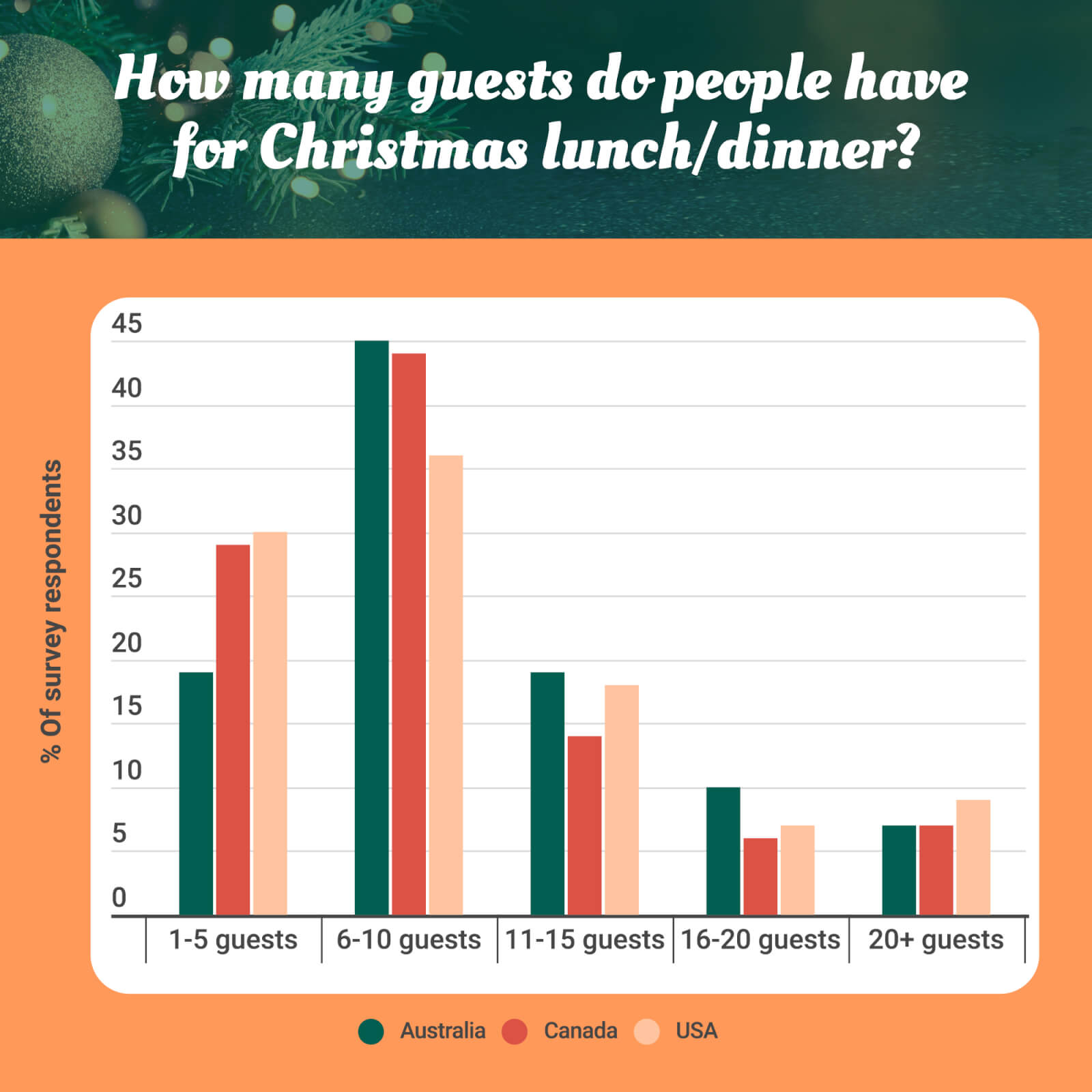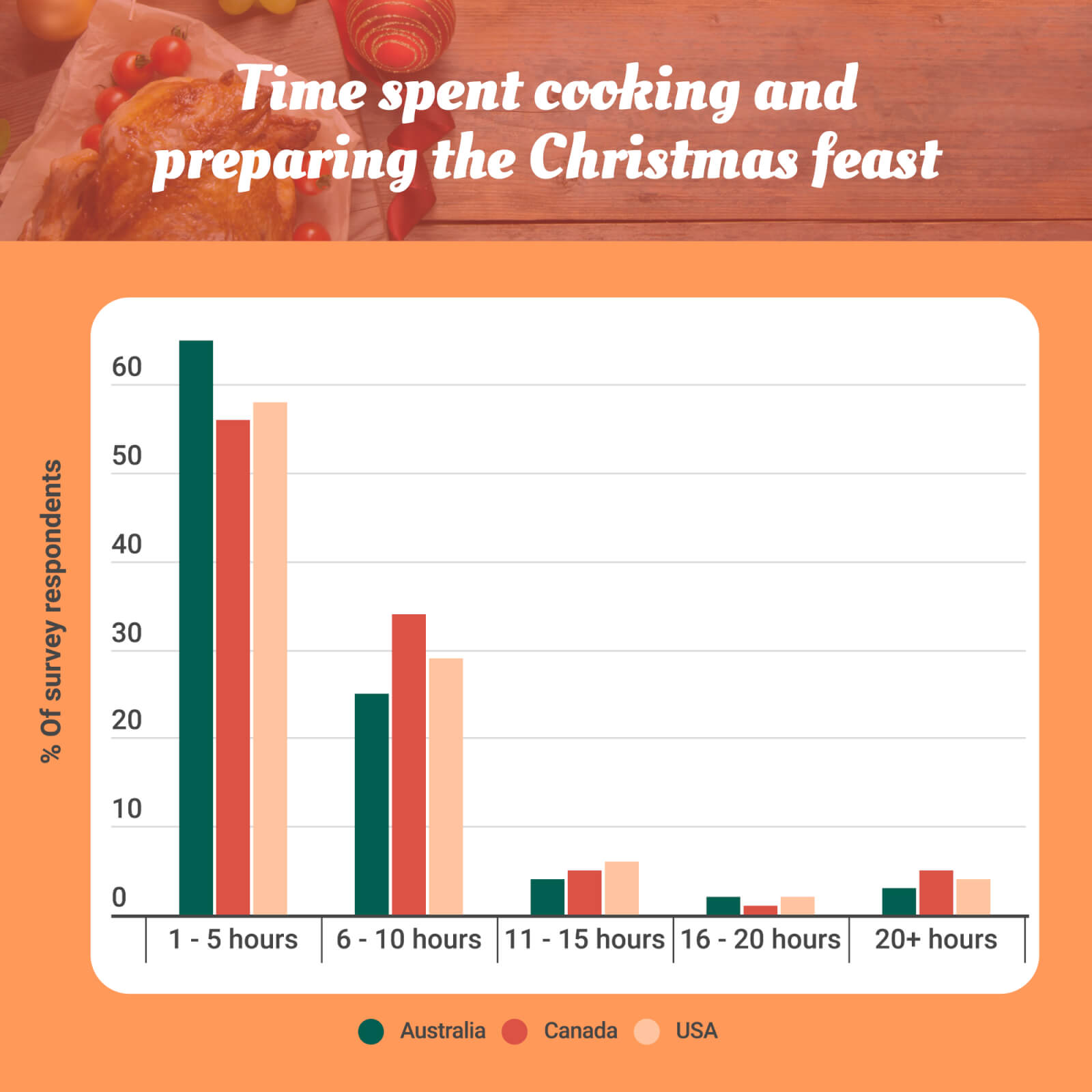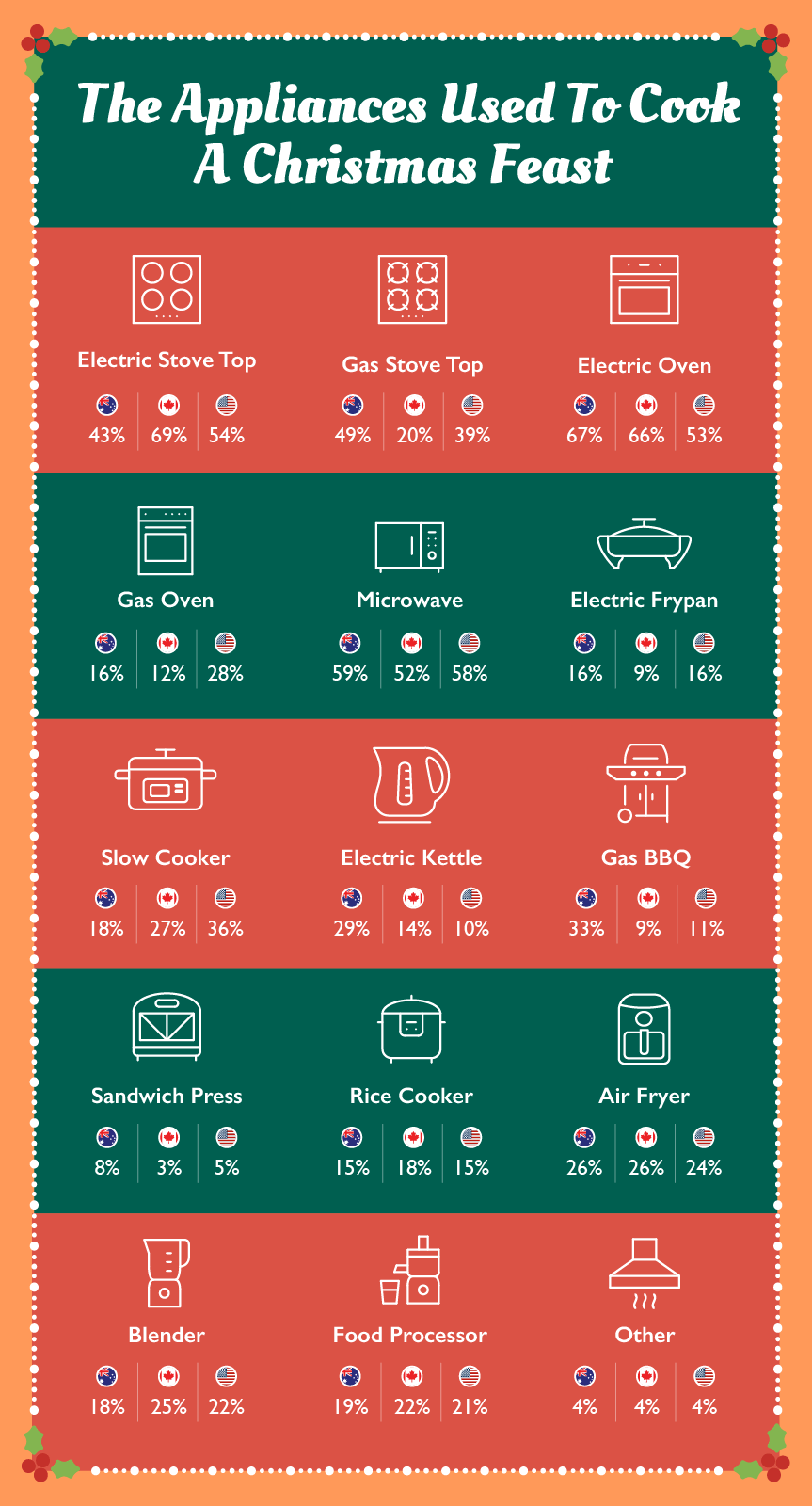The Burrow
There is a lot of work involved in making the ‘most wonderful time of the year’ so wonderful. Not only do we need to break out the Christmas tree and decorations from storage, but there is also the Christmas shopping, Christmas lights for the house and cooking the Christmas feast.
To figure out just how much goes into creating a merry Christmas experience for family and friends, the energy comparison experts at Compare the Market surveyed over 3,000 adults from Australia, Canada and the USA. We asked people what goes into hosting a Christmas dinner, how many lights they put up, and for how long.
Here’s what we found.
According to Compare the Market’s survey, more than 50% of respondents have hosted Christmas lunch or dinner at their place – 52% in Australia, 57% in Canada and 50% in the USA. When it comes to the number of guests people entertain during the festive season, the most common response from those surveyed was six to 10 guests.
Australians were more likely to host 11 to 20 guests than Americans and Canadians, but Americans were the most likely to host more than 20 guests for a Christmas feast – though none of these were the most common responses overall.
The graph below breaks down the number of guests that survey respondents say they entertain at Christmas.

For the majority of respondents, cooking and preparing the Christmas meal takes one to five hours. The next most common time frame is six to 10 hours, and this was common across all three nations surveyed. Australians were the most likely to spend under five hours cooking, while Canadians were the most likely to slave away in the kitchen for up to 10 hours.

When it comes to the appliances used to prepare sumptuous food there are typically multiple on the go at once. In Australia, the top three appliances were the electric oven, microwave and gas stovetop (in that order). In Canada the electric stove was the most popular, followed by the electric oven and microwave, while the microwave was the number one appliance for USA respondents. The next most popular appliances in the USA were the electric stovetop and electric oven.
Australians were more likely to use a gas BBQ and an electric kettle than their North American counterparts, while Americans were more likely to use a slow cooker than Canadians or Australians. The graph below breaks down the popularity of different appliances in Australia, Canada and the USA when it comes to preparing the Christmas dinner.

While there are a lot of appliances that might be getting used for multiple hours as you cook up a storm for your guests, the impact to your energy bill is likely to be small. Compare the Market’s General Manager of Energy, Anthony Fleming, explains.
“If you run an electric oven and microwave for four hours each, it could cost you around AU$4.76 (US$3.16) to cook that Christmas lunch or dinner.* While this is small in comparison to the rest of your quarterly energy bill, it is noteworthy when you consider most home appliances use very little electricity per hour,” Fleming says.
“Obviously, the more appliances you have running at once and the longer you run them for will increase your energy bill in return. The oven and stovetop are some of the most power hungry appliances in the kitchen, besides freezers, fridges and dishwashers.”
While the fridge and oven unit are some of the biggest energy consuming appliances in the home, Fleming notes that appliances in other parts of the house can be just as bad, if not worse.
“Washing machines, clothes dryers and heating or air-conditioning are some of the most energy intensive appliances people have in their homes. In Australia, air-conditioning can make up 50% of an energy bill in summertime. Reducing or changing how we use these appliances may have a more positive impact on your energy bill than skipping on a turkey this Christmas,” Fleming says.
Energy saving tips:
While there are dozens of little tips and tricks that can all add up and save you money on your energy bill, it also pays to compare energy plans. Comparing energy plans for electricity and gas can help you weigh up available offers in your area to see which deal is best for you. Comparison sites like Compare the Market in Australia make it easy to weigh up different types of tariffs and special offers in minutes, helping you save money on your energy bills.
A Christmas feast is just one icon of holiday cheer. Another quintessential, magical sight of the Christmas season is a home decorated with twinkling festive lights. However, adorning homes with lights is less common in the Land Down Under than North America.
Only 42% of Australian respondents indicated they would be decorating their homes with Christmas lights, compared to 63% of Canadians and 61% of Americans. The table below indicates how many lights people are covering their homes with and for how long, for each nation surveyed.
| Number of lights | Australian respondents | Canadian respondents | USA respondents |
| 1-50 | 39% | 26% | 23% |
| 50-100 | 24% | 33% | 23% |
| 100-500 | 20% | 26% | 24% |
| 500-1,000 | 11% | 9% | 19% |
| 1,000-2,000 | 3% | 4% | 8% |
| 2,000-3,000 | 1% | 0% | 1% |
| 3,000+ | 2% | 1% | 2% |
| Weeks of Christmas lights | Australian respondents | Canadian respondents | USA respondents |
| 1 – 2 | 19% | 16% | 21% |
| 3 – 4 | 46% | 35% | 39% |
| 5 – 6 | 24% | 24% | 26% |
| 7 – 8 | 6% | 12% | 8% |
| 9 – 10 | 2% | 5% | 2% |
| 11+ | 3% | 8% | 4% |
Modern LED Christmas lights are incredibly energy efficient. Compare the Market calculated some figures and found that 10,000 LED Christmas lights will add just AU$4 (US$2.43) to the average electricity bill for the whole month of December (running for four hours a night and all 31 days of Christmas).
This means that those getting into the Christmas spirit could run multiple sets of Christmas lights for a whole month at the same price as cooking Christmas lunch or dinner for one day, depending on how many lights and appliances are used.
| Number of LED lights | Cost of operating in Australia | Cost of operating in Canada | Cost of operating in USA |
| 20 | AU$0.05 | CA$0.03 | US$0.03 |
| 100 | AU$0.11 | CA$0.06 | US$0.07 |
| 250 | AU$0.12 | CA$0.07 | US$0.07 |
| 500 | AU$0.20 | CA$0.11 | US$0.12 |
| 1,000 | AU$0.40 | CA$0.23 | US$0.25 |
| 2,000 | AU$0.80 | CA$0.45 | US$0.49 |
| 5,000 | AU$2.00 | CA$1.12 | US$1.21 |
| 10,000 | AU$4.00 | CA$2.25 | US$2.43 |
| Notes: See the methodology below for information regarding the different calculations used in this table.^ | |||
“The biggest expense with Christmas lights is buying them in the first place, which can be quite expensive,” says Fleming, “but fortunately, actually running these lights is really cheap.”
“Also, if you buy solar lights this will avoid drawing on power from the energy grid and won’t add anything to your energy bills, making them a friendlier choice for your wallet and the environment.”

*This is based on a tariff of AU$0.29 cents per kWh for a 3,000-watt electric stove oven and a 1,100-watt microwave where both appliances are running for four hours straight.
^We selected four different sets of Christmas lights (Anko’s low voltage 20 colour changing starburst lights, Lenoxx’s outdoor/indoor 100 LED Christmas decoration lights, Anko’s low voltage 250 LED warm white string lights and Mirabella’s Christmas low voltage 500 LED string lights) with varying wattage to give us an idea of potential running costs.
The energy tariffs used in the calculations are average figures and were sourced from the following sites and are subject to change:
To calculate the cost of operating the Christmas lights, we took the individual wattage of each light to calculate a kWh consumption figure for each set of lights. These kWh figures were then calculated against the tariff to create a cost per hour. This figure was then multiplied by four to create a cost per night, and this was then multiplied by 31 to calculate a cost of operating figure for the month of December in each country.
Actual usage and costs can vary between brands and where a household’s energy plan tariff differs from the averages used in the calculations.
Prices for other figures outside of the Christmas lights running cost table were converted on 23/11/22 using Google’s currency converter tool.
Compare the Market commissioned Pure Profile to survey 1,006 Australian, 1,010 Canadian and 1,012 American adults in October 2022.